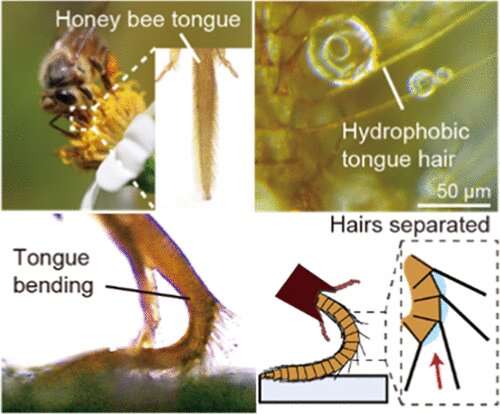In a surprise move, honeybee tongue hairs repel water

A honeybee pokes out its tongue—which is densely covered in hairs—to lap up nectar and other liquids. Now, researchers report in ACS Applied Materials & Interfaces that those hairs are water repellent. That’s unexpected, since most liquid-capturing organs in nature are hydrophilic, or water loving. But the hairs’ hydrophobic nature makes the tongue more flexible, which is useful when foraging from sources with differing shapes. The findings could help researchers design new materials.
A honeybee can feast on flower nectar, sap, fruit juice or salt water. That means its tongue must be able to interact with a broad spectrum of surfaces, such as narrow flower openings, coarse tree bark, irregularly shaped rotten fruit and damp soil. The insect’s success in exploiting these very different resources depends on the surface properties and deformability of its tongue, which consists of a series of ring-like segments, each bristling with 16 to 20 hairs that capture food. Researchers had previously studied the structure and motion of the hairs, but their surface properties and relationship to overall flexibility hadn’t received the same scrutiny. Jiangkun Wei, Zhigang Wu, Jianing Wu and colleagues set out to fill in the blanks.
The team used various forms of microscopy, along with high-speed videography and computational modeling, in their investigation. These techniques showed that the individual hairs are stiff and hydrophobic, unlike the ring segments, which are soft and hydrophilic. This difference prevents the hairs from sticking to and stiffening the tongue once it starts bending, so it can bend further to get into crevices and reach food. The stiffness of the hairs also enhances their durability, enabling the bee to use its tongue millions of times during its lifetime. The researchers say their findings could inspire the design of sophisticated new materials, such as flexible microstructured fiber systems to capture and transport viscous liquids.
Surprising spider hair discovery may inspire stronger adhesives
Jiangkun Wei et al, Enhanced Flexibility of the Segmented Honey Bee Tongue with Hydrophobic Tongue Hairs, ACS Applied Materials & Interfaces (2022). DOI: 10.1021/acsami.2c00431
Citation:
In a surprise move, honeybee tongue hairs repel water (2022, March 14)
retrieved 15 March 2022
from https://phys.org/news/2022-03-honeybee-tongue-hairs-repel.html
This document is subject to copyright. Apart from any fair dealing for the purpose of private study or research, no
part may be reproduced without the written permission. The content is provided for information purposes only.
For all the latest Science News Click Here
For the latest news and updates, follow us on Google News.

